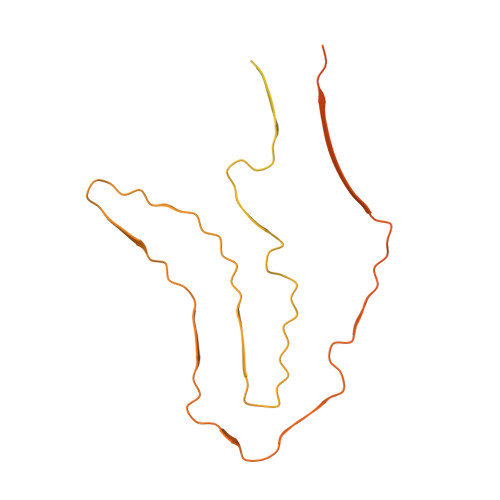Novel tau filament fold in corticobasal degeneration.
Zhang, W., Tarutani, A., Newell, K.L., Murzin, A.G., Matsubara, T., Falcon, B., Vidal, R., Garringer, H.J., Shi, Y., Ikeuchi, T., Murayama, S., Ghetti, B., Hasegawa, M., Goedert, M., Scheres, S.H.W.(2020) Nature 580: 283-287
- PubMed: 32050258
- DOI: https://doi.org/10.1038/s41586-020-2043-0
- Primary Citation of Related Structures:
6TJO, 6TJX - PubMed Abstract:
Corticobasal degeneration (CBD) is a neurodegenerative tauopathy-a class of disorders in which the tau protein forms insoluble inclusions in the brain-that is characterized by motor and cognitive disturbances 1-3 . The H1 haplotype of MAPT (the tau gene) is present in cases of CBD at a higher frequency than in controls 4,5 , and genome-wide association studies have identified additional risk factors 6 . By histology, astrocytic plaques are diagnostic of CBD 7,8 ; by SDS-PAGE, so too are detergent-insoluble, 37 kDa fragments of tau 9 . Like progressive supranuclear palsy, globular glial tauopathy and argyrophilic grain disease 10 , CBD is characterized by abundant filamentous tau inclusions that are made of isoforms with four microtubule-binding repeats 11-15 . This distinguishes such '4R' tauopathies from Pick's disease (the filaments of which are made of three-repeat (3R) tau isoforms) and from Alzheimer's disease and chronic traumatic encephalopathy (CTE) (in which both 3R and 4R isoforms are found in the filaments) 16 . Here we use cryo-electron microscopy to analyse the structures of tau filaments extracted from the brains of three individuals with CBD. These filaments were identical between cases, but distinct from those seen in Alzheimer's disease, Pick's disease and CTE 17-19 . The core of a CBD filament comprises residues lysine 274 to glutamate 380 of tau, spanning the last residue of the R1 repeat, the whole of the R2, R3 and R4 repeats, and 12 amino acids after R4. The core adopts a previously unseen four-layered fold, which encloses a large nonproteinaceous density. This density is surrounded by the side chains of lysine residues 290 and 294 from R2 and lysine 370 from the sequence after R4.
- MRC Laboratory of Molecular Biology, Cambridge, UK.
Organizational Affiliation:
















